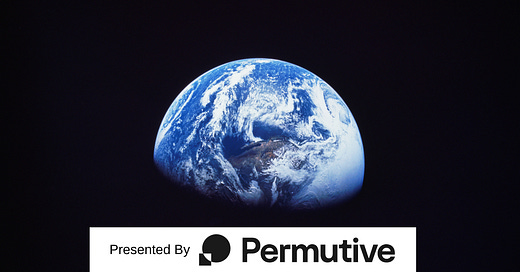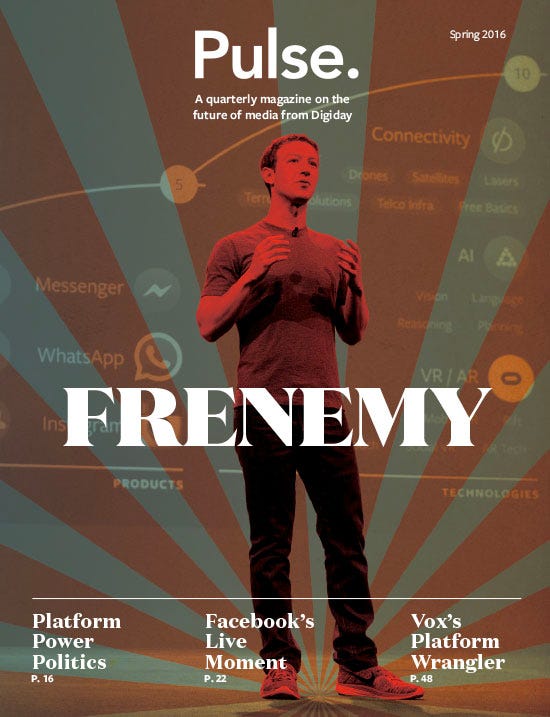Email is great because you get a direct connection with people. It isn’t that great in that it tells you some, but not too much, information. Please take a few minutes to answer this 10-question audience survey. It should take five minutes and will help in a few ways. One is to sell sponsorships because the information will help show who sponsors can reach with The Rebooting sponsorship programs. The other is to help as I expand The Rebooting. Thanks so much.
Audience-owners are the guardians of user data. By ensuring that it is protected, publishers and advertisers regain their central place in the process of discovering, planning for and activating audiences. Permutive ensures that every targeted ad impression, from open auctions to direct, is based on consented, non-PII, directly-sourced data. The Permutive Audience Platform empowers publishers and advertisers to responsibly activate audiences without any third-party access to personal data.
One of my favorite anecdotes for the oddity that is the media business came in the early pages of Googled, Ken Auletta’s story of the early days of the media businesses uneasy collision with tech. In 2003, Mel Karmazin, then CEO of a still-swaggering Viacom, visited Larry Page and Sergey Brin and learned how they’d built what was basically a perfect marketing engine that matched advertisers to users based on their expressed intent. His blunt reaction: “You’re messing with the magic.” (He didn’t say “messing,” but in the interests of optimization, I’m reluctantly censoring myself to improve email deliverability. Life is full of compromises.)
The media business was built on magic, the ability to manufacture the whiff of exclusivity, quality and cultural cachet that turns a piece of communications or entertainment into a valuable product. In the media business, every publisher assures you they are premium. I never in my career heard someone describe their content as “second rate” or “filler” or “stuff they show at dentist offices.” After all, who’s to say, really?
Back in 2016, we started a magazine at Digiday – and for some reason gave it a bizarre name, Pulse. I wanted to do a magazine mostly because of perception. It was an insane media product. We only printed about 1,000 copies the first run, and it was missing for weeks because we used the wrong printer. Somehow, the sales team even sold some ads at what must have been the highest-ever CPM. But a magazine was a way of signaling premium value. I was told it had to pass “the tie test,” meaning that it had to be thicker than a tie. (Speaks to how old school the magazine industry was.) Glossy covers, nice type, good paper stock – these are all classic ways to signal premium value.
Moving media to digital channels erased the concept of scarcity that drove media value. What Karmazin understood is applying math to media would separate the wheat from the chaff, and while John Wanamaker might want to know what half of his advertising is working, the ones selling the other half sure didn’t. Tech also zapped many of the distribution advantages publications had. Google and Facebook flattened distribution and gave control to tech companies, relegating all publishers to the same treatment in a scroll of links.
Publishing brands could still signal premium value through their packaging on websites. After all, good design shows you give a shit. Original photography was another method. Same for illustrations, slick videos on an embedded Brightcove player and incredibly hard to navigate animations. These are “costly signals” as recently identified by Every’s Nathan Bashez:
There are universal principles of visual design that matter across time and in every cultural context. But also, there are certain processes and materials that are seen as premium. This is context-dependent; it changes over time based on technology and economics. When a design uses a premium material like an illustration or an intricate 3D rendering, it is seen as an honest “costly signal” that the company behind it has lots of resources to spare. This, more than grid alignment or proper typographic hierarchy, is the thing that sends a tingle down your spine and makes you think “I should sign up.”
These signals were, of course, weaker than in analog media but still real. Those are being erased now, mostly as publishing moves to different surface areas and what Troy Young calls “full composability”: “Our state of near full composability is the inevitable product of three plus decades of innovation in communication technology, in particular tools that support ubiquitous creation of sophisticated, high quality personal media.”
This is an important point that hints at a larger change to how value is signaled if we move to primary-engagement media. Media will always attract grifters who hand-wave their way to success. But my bet is the breakouts of the coming years will be more rooted in substance than pizazz. And much of that is because the unfair advantages of being bigger are going away. Access to high-quality photography and design is now widely available. Design tools like Canva make an art department less of an advantage. DALL-E points to high-end illustration going that way. There will always be a place for craft, don’t get me wrong, but it will become harder to signal premium value through packaging.
And beyond that, expectations are changing. Across society, we’re seeing a creeping casualization. I found it noteworthy that Antony Blinken, the U.S. secretary of state, gave a very important official statement last weekend while wearing sneakers. To be clear, I believe a well-made pair of sneakers to be as premium as a pair of loafers, but it struck me we’ve come a long way from when conservatives lost their marbles at Obama wearing a tan suit. The pandemic normalized casual, making the idea of dressing in uncomfortable clothing to work as weird as wasting two hours a week on a commute to an office to work at a computer.
Take video. It required significant upfront investment to reach a production quality level that maybe could make it worthwhile. But once CNN started airing Zoom video, it was signaling a more casual mode of video that does away with many of the high production costs. Tools like Riverside allow an individual to publish good-enough quality video.
Newsletters and talk-format podcasts got there first. Both are so constrained in their formats that differentiating through production quality is difficult. Is Bloomberg’s Money Stuff any more “premium” than Adam Tooze’s Chartbook? Both are great, but I can’t say the product experience of a Substack newsletter is worse than one coming through Sailthru. Podcasts have long been this way. There is room for the highly produced variations on radio, like The Daily, but most popular podcasts – not narrative ones – are far more casual and under-produced, sometimes to a fault. (I draw the line at dogs barking in the background and waiters clearing glasses.)
And that’s in large part because the packaging of primary-engagement media is different. Websites are less important. The fancy CMS is no longer a massive competitive advantage; in many cases, it is an albatross because it traps publications in pageview models. If you spent the last decade installing programmatic ad technology, you can be sure you’re going to use it. Powerful media brands are emerging that do not lean on any of these surface-level abstractions to lay claim to being “premium.”
Publications will be judged by how valuable their communities are – and the connection they have to them. Much of the media business is still stuck in low-engagement mode. CNN fooled itself into thinking it was the type of primary-engagement media that thrives in a direct-to-consumer model. On the contrary, CNN has long been low-engagement ambient media that plays in the background. CNN+ would sometimes have a few thousand viewers at a time. I would bet a Barstool+ would outdo that while spending about 1/100.
Of course, audiences can be bought. That’s why you see so many media companies with hundreds of thousands of followers that seem to have very little actual engagements. Open rates of 20% are common. Many have bounce rates over 80%.
Publishing has a long history of arbitrage opportunities, looking for new distribution channels where measurement has not matured. In the end, I think a lot of these efforts won’t work beyond selling some ads. The strongest brands will have real connections with real people. They’ll be able to motivate those communities to take actions and connect to each other. The biggest value of many subscriptions and memberships is that they are proof points that show a publishing brand is premium in the eyes of their audience/community. Of course, even here, many are faking it and won’t make it. That’s also a reason why subscriptions and ads work together.
Publishers will need to adapt to the changes in signals. The way to signal premium value for a community is through the talent in the organization. That’s why the personal brand debate is particularly silly because it will become essential for brand value. And they’ll signal premium value by the talent profile of those in the community they serve, particularly the most ardent believers. That should lead to less of a premium played on the fakery, both mild and egregious, that’s too often defined the media business.
Good job alert
Observer Media, home to Observer and Commercial Observer, is looking for an events director to lead its growing (and profitable) events business. This person will lead a small team of events coordinators, manage external agencies, and interface with the company's executive team to ensure in-person and virtual events are industry-leading, innovative and memorable. This position, which reports to CEO Michael Rose, requires someone comfortable interacting with high-profile, C-level executives, as well as able to set overall strategy and manage execution to meet all goals, including revenue and profit. The job is based in New York City. If you’re interested, send me a note, and I’ll put you in touch.
Recommendations
Figuring out growth levers changes over time. Louis Nicholls at Send & Grow has a good framework for how newsletters should approach their growth tactics – and how they change based on the scale (and audience focus) of the newsletter.
Maybe the vibe shift is really rethinking paywalls as panaceas. Jack Marshall at Toolkits has a nifty graphic that showcases how many publishers are adopting paywall strategies that are misaligned with their content approaches. You can put a saddle on a donkey, doesn’t make it a horse.
And maybe it’s because publishers have exhausted the market of people willing to pay for news and commentary. Simon Owens goes through the sometimes contradictory evidence and arrives at the conclusion that paywalls were never a silver bullet and often need to be overhauled before they hit a churn spiral.
The rise of the illiberal left is getting pushback from old-school liberal quarters, first in The New York Times and now in a new piece in New York magazine. The free expression wars, inevitable with Elon Musk’s purchase of Twitter, will scramble a lot of the tribal politics we’ve been stuck in. There are many people with different political policy preferences who are uneasy by how intolerance is spreading in so many areas.
WeCrashed is a fun series. Maybe I’ve been living in Miami too long, but I was inspired by the Neumanns belief in the power of manifestation. I’d take that over self-delusion any day, and walking around without shoes should be normalized.
Thanks for reading. Send me a note with your thoughts: bmorrissey@gmail.com.











Premium is in the value of the community. I love this Brian. Certainly what we should shoot for. But I'm still looking for some more good visuals as well.